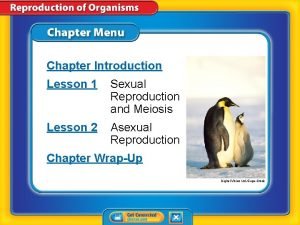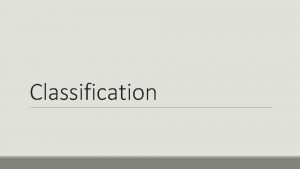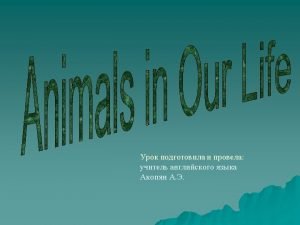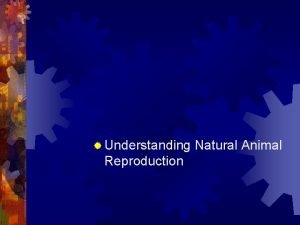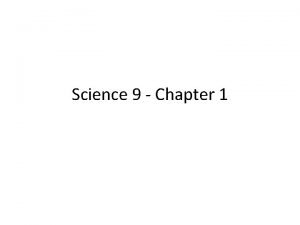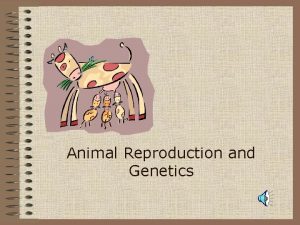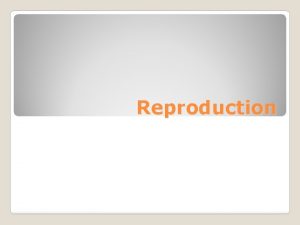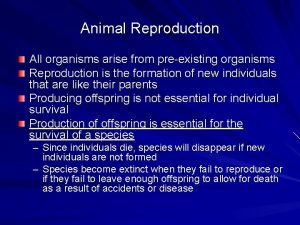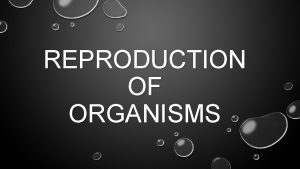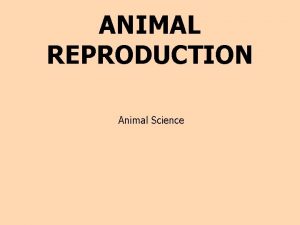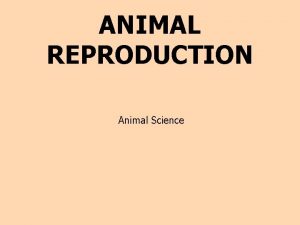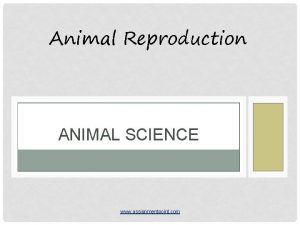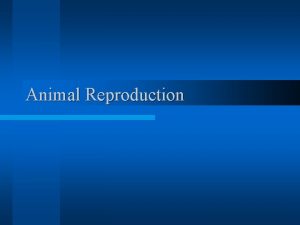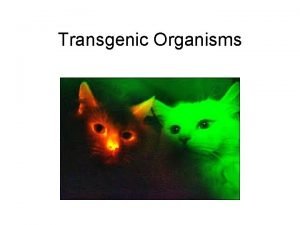Animal Reproduction Terms Animal Science Reproduction when organisms



















- Slides: 19

Animal Reproduction Terms Animal Science

• Reproduction: when organisms multiply or produce offspring • Sexual Reproduction: involves the union of a male and female gamete • Asexual reproduction: does not involve gametes -Ex. Simple cell division

• Copulation: The mating of a male and female • The male gamete (sperm) is placed in the reproductive tract of the female • Sperm moves toward egg cell • Fertilization: occurs when sperm penetrates the egg cell

• Embryo: the new animal • Parturition: act of giving birth • final step in reproduction

Male Reproduction Parts • Scrotum: saclike part of the male reproduction system – Outside the body cavity – Contains the testicles and epididymis • Sterile: cannot produce live sperm • Ridgeling/ Ridgel: male with 1 or both testicles held in the body cavity

• Cryptorchidism: when a male has 1 or both testicles held in the body cavity • Testicles: produce sperm - produce hormone – testosterone • chemical compounds that help regulate body functions

• Epididymis – tube connected to each testicle – Sperm cells stored here while they mature • Vas deferens – connects epididymis with urethra • Spermatic cord – sheath that protects vas deferens

• Urethra – tube carries urine from bladder - Found in both males and females - Semen also moves through the urethra • Accessory glands - create fluids for certain tasks – - Seminal vesicles – open into urethra – - Fluid protects and transports sperm – - Prostate gland – near the urethra and bladder • - Fluid mixed w/ seminal fluid – - Cowper’s gland – Fluid moves ahead of seminal fluid • - Fluid cleans and neutralizes urethra

• Semen – mixture of seminal and prostate fluid and sperm • Penis – deposits semen w/in female reprod. System • Signoid flexure – extend penis from sheath • Retractor muscle – extend penis from sheath – Draws penis back into sheath after copulation • Sheath – tubular fold of skin

Female Reproductive Parts • Female parts are very different from male parts • Produces female gametes / sex cells eggs • Must provide a place for fetus to grow

• Fetus – embryo in later stages • Ovaries – cow has 2 – - Hundreds of tiny follicles – - Produce eggs – - 2 Female sex hormones are also produced here • - Estrogen & Progesterone

• Ovaries also form the Corpus Luteum • Oviducts – 2 tubes – Carry eggs from ovaries to uterus – Fallopian tubes • Infundibulum – Funnel-shaped end of each oviduct that is close to the ovary

• Uterus – place for fetus to grow – - Womb – - Has 2 horns or branches that are connected to oviducts • Cervix – neck of the uterus – - Separates uterus from vagina • Vagina – passage between cervix and vulva – - Fetus passes through at birth • Vulva - external opening of the reproductive & urinary systems

Breeding • Estrus Cycle – Estrus – also known as heat – Time during which the female will accept the male for copulation – Begins when old enough to be bred – Begins when a follicle on the ovary begins to develop – Estrogen causes the animal to show signs of heat

• Ovulation – release of the egg cell from the ovary – # of young indicates # of egg cells – Usually near end of cycle – Follicle breaks open & releases egg into oviduct

• After ovulation corpus luteum forms on ovary – - Releases progesterone • • 1) Fertilized egg implanted in uterus 2) Other eggs are stopped from forming 3) Maintain pregnant condition 4) Begin development of mammary glands produce milk

• Atrophy -wastes away -if not fert. • Fraternal twins – animal releases more than 1 egg at ovulation • Identical twins – egg cell divides to form 2 animals

• Fertilization – union of sperm and egg cells – Occurs in infundibulum – 1 sperm cell • Gestation – time during pregnancy • Umbilical cord – carries nutrients through blood vessels and oxygen & carry off waste • Placenta – attached to umbilical cord • Diffusion – movement of food, oxygen, and wastes from areas of high concentration to low

• Parturition – process of giving birth • Progesterone decreases • Estrogen increases – uterine muscles contract • Umbilical cord broken @ birth • - Colostrum – 1 st milk – - Rich in antibodies, vitamins, & minerals needed – - Antibodies – substances that protect animal from infections and poisons – - Afterbirth – placenta and other membranes not expelled
 Competitive interaction
Competitive interaction Unicellular and multicellular organisms
Unicellular and multicellular organisms Connecting the concepts sexual reproduction
Connecting the concepts sexual reproduction Reproduction examples
Reproduction examples Sexual and asexual reproduction venn diagram
Sexual and asexual reproduction venn diagram Sexual reproduction and asexual reproduction
Sexual reproduction and asexual reproduction Asexual vs sexual venn diagram
Asexual vs sexual venn diagram My favorite subject science
My favorite subject science Polynomial classification
Polynomial classification Like terms
Like terms Kingdom genus species family class order
Kingdom genus species family class order This is the study of grouping and naming organisms
This is the study of grouping and naming organisms Canis latrans classification
Canis latrans classification Sosieti
Sosieti Natural animal reproduction
Natural animal reproduction Venn diagram of plant and animal reproduction
Venn diagram of plant and animal reproduction Basic animal reproduction vocabulary
Basic animal reproduction vocabulary Natural vs social science
Natural vs social science Branches of science mind map
Branches of science mind map Natural and physical science
Natural and physical science


